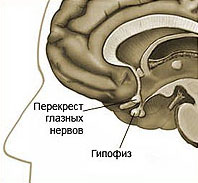What are the causes of hyperprolactiakiyia? How to diagnose hyperprolactinemia? How to treat hyperprolactinemia? Answers to these questions you will find in the article.
Content
Prolactin in blood. Usually, the level of prolactin in the blood increases in
pregnancy and breastfeeding time, which leads to workout
milk. As soon as the woman ceases to feed the child, the level
Prolactin decreases to normal. If the level of prolactin increases not
during pregnancy or not decreased to the norm after the termination
breastfeeding, then such a state is called hyperprolactinemia.
One of the symptom of hyperprolactinemia is
impairment of menstrual cycle (rare menstruation or full of them
No), since the elevated level of prolactin violates synthesis
Follicularity Muling Hormone (FSH) and Lutinizing Hormone (LH),
regulating menstrual cycle. This is largely the cause
Infertility in women with hyperprolactineia. Patient S
hyperprolactineia can also suffer from headaches, they can
There is a decrease in sexual entry.
In 30% of women with elevated prolactin content
Galactere is found (milk isolation from the mammary glands).
The occurrence of the galactoria depends on the level of hormone content. She is ne
is a manifestation of any disease of the mammary glands, for example,
Cancer, and arises due to physiological influence prolactin.
(raising the level of men's genital hormones) and acne are found at 20-25%
Patients with hyperprolaktemia.
There are many reasons for pathological
Raising prolactin levels in blood. Even such a minimum stress
Before taking blood for research, like a gynecological examination or
The study of the mammary glands can lead to short-term
Enhance the content of prolactin.
The hormone level may increase due to admission
certain drugs, such as antiemetic,
Neuroleptics, estrogen, opiates, contraceptive tablets. If
During the study in the blood, the elevated level of prolactin was discovered,
Be sure to inform the doctor about the reception of these drugs.
The cause of hyperprolactinemia can be transferred
radioactive irradiation, transferred operations on lactic glands and
Chest organs, syndrome «empty» Turkish saddle (Turkish
saddle is bone education on the basis of a skull in which
Located pituitary.
The reason for the elevated level of prolactin may be
Also chronic liver and kidney failure, insufficiency
Functions of the thyroid gland (hypoteriosis) and a number of other endocrine
Diseases (Incenko-Cushing's disease, polycystic ovarian syndrome).
In addition to a variety of endocrine and non-iconic
diseases, hyperprolactinemium can be caused by a benign
Tumor hypothalamic-pituitary area - adenoma pituitary,
producing prolactin (prolactic). Adenoma grow very slowly
or do not grow at all. What exactly causes their education, while before
End is not clear.
Microprolactine (up to 10 mm in diameter) and
Macroprolactinoma (more than 10 mm in diameter) are frequent cause
hyperprolaktemia. Increased prolactin levels detect in 20-25%
Patients with infertility and various impaired menstrual cycles,
Moreover, 40-45% hyperprolactinemia is due to the presence of a tumor
pituitary.
It should be noted that quite often increased
Prolactin level occurs in the absence of the above
Pathologies. This is the so-called «idiopathic», or «Functional»
The shape of hyperprolaktemia. Its reason lies in an increased function
Cells secreting prolactin.
How to diagnose hyperprolactinemia
Diagnosis of hyperprolactinemia includes:
-
determining the level of prolactin and other hormones in the blood plasma;
-
Craniogram (Head X-ray);
-
X-ray computed tomography or nuclear magnetic resonance (NMR) tomography of the head;
-
Study of the eyeboard and fields.
 If, according to the results of the blood test, it turns out that
If, according to the results of the blood test, it turns out that
The level of prolactin is increased, and there are no other manifestations of hyperprolactinemia,
then it is necessary to repeat the analysis to eliminate the error. Blood fence for
Prolactin content analysis should be made from 9 to 12 am
on empty shop. A woman should relax well, on the eve abstracted from
sexual intercourse.
The diagnosis of hyperprolactinemia can be delivered at
Two discovery of elevated prolactin. For most
Laboratories Upper border of the rate of hormone - 500 mm / l or 25 ng / ml.
The level of prolactin to some extent may indicate the cause
hyperprolactinemia: at the level of prolactin, exceeding 200 ng / ml (4000
honey / l), usually there is a pituitary macroenoma; at the level of prolactin
less than 200 ng / ml (4000 honey / l) most likely diagnoses - microenoma
pituitary or idiopathic hyperprolactinemia.
In addition to determining the level of prolactin, it is necessary
Be sure to check the function of the thyroid gland, as well as determine
Level of other hormones.
You should also make a craniogram for visualization
Turkish saddle. In 20% of patients on the craniogram, an enlarged is determined
saddle, «Double» bottom, expanding the entrance to the Turkish saddle, which is
Signs of presence of prolactinoma (macroenomes) pituitary. In those cases,
When there are no changes on the craniogram, it is recommended to conduct
X-ray computed tomography or NMR tomography to identify
The microprolactin of the pituitary size is less than 10 mm.
If the presence of macroenomes is confirmed,
Examination of the eyeboard and fields of view to identify distribution
Tumors beyond the Turkish saddle - on the crossroads of optic nerves.
How to treat hyperprolactinemia
Methods of treatment of hyperprolactinemia include drug treatment, radiation therapy and surgical intervention.
With hyperprolactinemia caused by microen
pituitary or functional increase in the level of prolactin, the main
is the use of dopamine agonists contributing to the decrease
Prolactin production, the level of which in the blood is often reduced to the norm
A few weeks after the start of treatment.
These drugs are prescribed by cycles for 6-24 months. During their reception, the level of prolactin is controlled and measured basal temperature.
As prolactin is normalized, menstrual cycle is restored and
Ovulation (in 80% of cases), in 70% of cases a pregnancy occurs.
Against the background of drug intake, almost all prolactinities
decrease in size. When macroenomes pituitary, the question of the method
Treatment is solved jointly with a gynecologist and neurosurgeon. In connection with
The effectiveness of drug treatment during prolactinities is rare
Resort to operations and radiation therapy. Only a small part of patients with
macroprolactinomes that have a tumor size not decreased on the background
drug treatment may need an operation. This operation B
Currently is carried out through a small incision near the nasal sinuses.
Sometimes experts are recommended to conduct radiation therapy, which allows
Stop receiving medication. However, it is possible to develop
Lack of pituitary gland.
As treatment may also be appointed
Some hormonal preparations: glucocorticoids in the presence of
adrenal insufficiency, L-thyroxin in the presence of insufficiency
thyroid gland (hypothyroidism) and sex hormones (estrogens) in
as replacement therapy.
Patients with hyperprolactinemia should be constantly observed with specialists.









